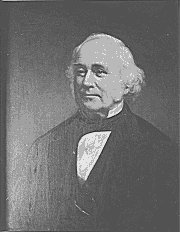Ichabod Goodwin
Ichabod Goodwin | |
|---|---|
 | |
| 27th Governor of New Hampshire | |
| In office June 2, 1859 – June 6, 1861 | |
| Preceded by | William Haile |
| Succeeded by | Nathaniel S. Berry |
| Personal details | |
| Born | October 8, 1794 Berwick, Massachusetts, U.S. (known today as North Berwick, Maine) |
| Died | July 4, 1882 (aged 87) Portsmouth, New Hampshire, U.S. |
| Political party | Republican |
| Signature | |
Ichabod Goodwin (October 8, 1794 – July 4, 1882) was the 27th governor of New Hampshire from 1859 to 1861.
Life and career
Goodwin was born in 1794 in the community of Berwick, Massachusetts (which is today known as North Berwick, Maine). He became a merchant in Portsmouth, New Hampshire, working in the counting house of Samuel Lord, becoming master and part owner of several ships, and eventually the owner of two railroads, two banks, and a textile factory.[1] In 1827 he married Sarah Parker Rice. Their daughter Susan married admiral George Dewey.

Goodwin was elected a State Representative, running as a Whig, in 1838, 1843, 1844, 1850, 1854, and 1856. In 1856 he ran, and lost, as the last Whig candidate for Governor of New Hampshire. He switched parties, becoming a Republican, and won his bid for governor in 1859, and again in 1860. He was a delegate at large from New Hampshire to the national conventions at which Henry Clay, Zachary Taylor, and Winfield Scott were nominated by the Whigs for the presidency, serving as vice-president of the first two bodies.[2]
During his tenure, the New Hampshire legislature did away with the Courts of Common Pleas, transferring their duties to the State Supreme Court. Goodwin supported a legislative resolution opposing the extension of slavery, and an anti-immigrant act aimed at the defining of police courts' powers to suppress "intemperance." He also supported efforts to regulate railroads.
Goodwin's business interests were heavily interlinked with raw materials, such as cotton, produced by slaves in the Southern States and elsewhere.[3]
In May 1861, as the Civil War began, Goodwin responded to the first calls for soldiers by borrowing funds against his own name to equip two regiments. The legislature affirmed the Governor's action when they came into session the following month.
He died in Portsmouth on July 4, 1882.[4]
Honors

In 1888, a zinc monument to New Hampshire soldiers and sailors who served in the Civil War was dedicated in a new park.[5] The park was named Goodwin Park in honor of Goodwin's service during the war.[5] The park and statue were located across from the Goodwin family mansion on Islington Street.[5]
In 1963 the Goodwin Mansion, facing demolition, was relocated from Islington Street to Strawbery Banke for preservation.[6] In 1970 the house was formally deeded to Strawbery Banke by the State of New Hampshire.[6]
Archives and records
- Ichabod Goodwin business papers at Baker Library Special Collections, Harvard Business School.
References
- ^ Penrose, Charles (1956). Ichabod Goodwin (1794–1882). Newcomen Society in North America. Retrieved April 27, 2011.
- ^ Badger Clarke, John (1882). Sketches of successful New Hampshire Men. J.B. Clarke. Retrieved April 27, 2011.
- ^ Sammons, Mark J.; Cunningham, Valerie (2004). Black Portsmouth: Three Centuries of African-American Heritage. Durham, New Hampshire: University of New Hampshire Press. pp. 128. ISBN 9781584652892. LCCN 2004007172. OCLC 845682328. Archived from the original on August 10, 2016. Retrieved July 27, 2009.
- ^ Johnson, Rossiter; Brown, John Howard, eds. (1906). The Twentieth Century Biographical Dictionary of Notable Americans. Vol. IV. Boston: American Biographical Society. Retrieved March 29, 2022 – via Internet Archive.
- ^ a b c Robinson, J. Dennis (1999). "Our Monuments: Soldiers and Sailors, Portsmouth NH". Seacoast NH. Archived from the original on May 12, 2015. Retrieved May 31, 2017.
Dedication of the Sailors and Soldiers Monument on July 4, 1888 was marked by pomp, parades and oration at the new Goodwin Park area. The new park was named for Ichabod Goodwin of Portsmouth, New Hampshire governor during the Civil War. It was located across from his family mansion on Islington Street.
- ^ a b "Goodwin Mansion". Strawbery Banke Museum. Archived from the original on May 28, 2022. Retrieved March 29, 2022.

